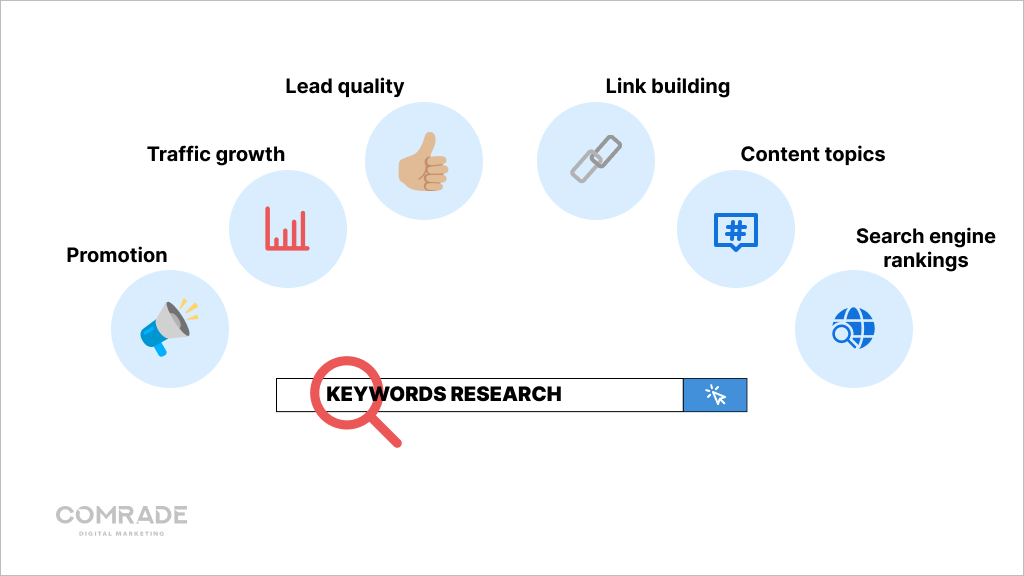Continued advancements in AI and natural language processing, as well as the emphasis on publishing content according to E-A-T signals (expertise, authoritativeness, and trustworthiness), have become a 2024 SEO priority.
Additionally, Search Intent continues to be a critical influence in performing keyword research and creating high-quality content that drives customers down the sales funnel.
Because Google and the ways consumers search are constantly evolving, it’s important for businesses to keep their fingers on the digital marketing pulse so that they can reap the rewards of a robust up-to-date SEO strategy.
Does SEO Still Work for Ecommerce?
Just because SEO trends change doesn’t mean the process is irrelevant. In fact, SEO is the bedrock of eCommerce digital marketing efforts. Of course, some SEO tactics that were effective in the past have ceased working as search engine algorithms have evolved to better match user intent and eradicate spammy, ineffective tactics.
Thus, SEO remains an excellent investment for all eCommerce brands. It can help your online business understand its target audience, boost your Google Ads’ quality score, and attract large volumes of organic traffic.
Because your SEO strategy isn’t set in stone, it’s essential to evaluate current tactics and update them where necessary to maximize search engine ranking potential. Let’s take a look at the top 10 SEO trends in 2024 that augment website visibility and conversion rates.
1. Page Speed and Technical SEO Are Still Important
Perfecting technical SEO is critical to ensure your eCommerce website is easy to navigate and free of any technical glitches that prevent it from being understood and ranked by search engines.
Page Speed
The quicker your page loads, the higher your online store will rank. Why? Fast web pages provide a seamless user experience that increases customer engagement and encourages visitors to spend more time exploring your web page content.
On the contrary, when web pages take too long to load, visitors grow impatient and leave, increasing bounce rate and reducing average page time. The end goal is always to have fast-loading pages across devices—ideally less than two seconds!
Core Web Vitals
In 2020, Google introduced Core Web Vitals (CWV) —three metrics that score a user’s experience loading a web page. These are official ranking signals that impact SEO.
Core Web Vitals is made up of three interaction measurements, namely: largest contentful paint, first input delay, and cumulative layout shift. In layman’s terms, Google assesses how quickly page content loads, how fast a browser loading a web page can respond to a user’s input, and how stable the content is as it loads in a browser.
Even though CWV doesn’t directly improve organic rankings, it provides your target audience with a superior user experience. And that translates into higher conversion rates.
In short, it’s like a “page experience” score, i.e. Google’s way of determining the quality of your webpages overall UX. Improving your website’s Core Web Vitals by optimizing server loading times, stabilizing loading, and improving the loading time of third-party scripts on your site is a vital component of SEO in 2024.
2. Be Mobile-First

How does your eCommerce website stack up in a mobile-first, consumer-driven landscape? More and more people are shopping on their smartphones and tablets. In fact, 79% of smartphone users have made a purchase online using their mobile devices in the last six months.
Google also indexes a website’s mobile version. Needless to say, if your web design isn’t responsive, it won’t rank very high. But what exactly does it mean to opt into mobile-friendliness?
A mobile-friendly website is one that is optimized to work across devices, so customers have a pleasant user experience regardless if they shop via desktop or mobile. Online stores that fail to make a sincere, strategic effort to deliver a positive online shopping experience on mobile risk falling drastically behind their competitors.
3. How to Make Content that Positively Impacts SEO
Whether it’s images, videos, articles, or blogs—prioritizing quality content attracts more traffic to your store and distinguishes your business from your competition. In 2024, content still reigns as king!
Create High-Quality Content

Your content must be unique, valuable, and look professional. Quality refers to a couple of things like error-free copy and attractive images, as well as publishing useful information your target audience enjoys engaging with.
As a general guide, you always want to write for people and not search engines. Weaving the right keywords into web copy with high readability is easier said than done, but is key to on-page SEO success.
Additionally, when creating content, you must consider E-A-T (expertise, authoritativeness, and trustworthiness). This is part of the search engine’s algorithm and Google’s Search Quality Evaluator Guidelines.
E-A-T is how Google ensures it returns accurate, truthful, and useful content to searchers. Therefore, it considers the expertise, authoritativeness, and trustworthiness of the individual creator of page content, the content itself, and the entire website when ranking a web page in search results.
Capitalize on Video Content
Video content makes up more than 82% of all consumer internet traffic. Incorporating relevant videos increases user engagement on digital and social channels and educates your audience in a medium that is easy for them to digest.
Existing and potential customers tend to like watching the following types of video content:
- Explainers that help them understand more about how a product or service works, or why they may benefit from either.
- Interviews that encourage conversations thematically related to a brand or its products or services.
- Product reviews and demo videos are often more effective than instruction manuals.
Don’t Use Stock Images
Consumers are smart and can spot stock images from a mile away. It doesn’t matter if they’re high-quality images; chances are another company has the same image on their eCommerce store’s website, which just makes you look cheap and unoriginal.
Always use your own photographs and images and make sure the visuals are relevant and support what the accompanying text is about. It might seem cheaper to purchase stock photos, but these costs can add up if you have to buy new images for each social media post and every website page.
If you factor in the time and energy spent to find the best image for each project, it’s actually more cost-effective and better for your brand to create your own.
Conduct Ecommerce Keyword Research

Every eCommerce SEO strategy begins with keyword research. This process ensures you’re targeting the right words in your on-page SEO strategy and maximizing your eCommerce SEO efforts.
Often companies make the all-too-common mistake of focussing on short keywords, yet long-tail keywords are better indicators of customers’ search intent—if a person looks for something specific, they’re more likely to buy it!
There are three main ways to do keyword research. You can use different search engines to see the most popular search results, conduct competitor research to familiarize yourself with the types of content you should focus on, or use a range of keyword tools specifically designed to perform in-depth keyword research. If you can, do all three.
4. Highlight Your Strengths
Showcasing testimonials and reviews and setting up structured data is great for SEO and improves consumer trust in your brand.
Request Customer Testimonials
Consumers love social proof, i.e. outside validation, AKA testimonials, and use them to gauge whether they should do business with you. Most customers don’t mind providing testimonials, so long as it’s easy. Consequently, a lot of eCommerce stores ask for them via mail or directly through their app (if they have one) after a customer has made a purchase.
Set Up Structured Data
Structured data helps search engines understand your web page content better and faster, enhancing visibility in search results.
By marking data on your web page in this manner, you increase the chances of appearing in rich snippets which, unlike normal Google search results, have extra data displayed.
Rich snippets rank higher than organic results, and thus have a higher click-through rate, generating more traffic to your website.
Showcase Product Reviews
Just like testimonials, individual product reviews prove to customers they can trust you and send a positive signal to search engines boosting the credibility of your online store. Product reviews are arguably the most useful way to eliminate a shopper’s concern about your products and services. Requesting and showcasing reviews is well worth the effort, given that 90% of consumers read them before purchasing products.
Diversify Your Marketing Channels
Search engines prefer to see organic traffic directed to your online store from multiple sources, such as social media channels, email addresses, etc. But more than that, you won’t generate the revenue you desire if you don’t use multiple marketing channels.
Marketing on multiple channels (the ones your target audience uses) drives demand for your product or service and helps build brand awareness and conversions from the top of the funnel all the way to the bottom.
Channel diversification also allows your brand to have a greater reach, making your products or services easier to find. Getting exposure from different channels helps you meet existing and potential customers where they are. After all, discovery won’t happen on your website alone.
5. Optimize for Voice Search

Over the past year, 58% of consumers have found local businesses using voice search, and 71% of consumers say they prefer to conduct search queries via voice instead of typing, which has had a significant impact on SEO trends.
Voice search customers use an average of 29 words made up of mostly long-tail keywords. Google relies heavily on featured snippets and knowledge graphs to answer voices, so you’ll want to work on optimizing those. Having a high domain rating and optimizing your eCommerce site for local searches will also help you attract voice search customers.
6. Improve User Experience
It’s easy to get so caught up in ranking high on Google’s search results that you forget about providing customers with the best possible shopping experience. That’s why we recommend our clients periodically perform a user experience audit (UX audit) to pinpoint unoptimized areas of their eCommerce stores that stymie conversions.
Through regular auditing, you create better alignment between your eCommerce business and website visitors. A UX audit is like a health check for websites that have been live for some time. With it, you can assess existing user flows and detect problems or bottlenecks that prevent potential customers from taking your desired action.
7. Refresh Existing Content
Keeping up with the fast-paced nature of content marketing is a challenge, especially since search engines are designed to find and prioritize relevant, fresh content, meaning older pieces will slowly drop in rankings and traffic. What’s the secret?
Thankfully, you don’t have to reinvent the wheel. A lot of your existing content can be updated and refreshed. This takes less work than creating something from scratch and simultaneously increases your ranking potential in search results.
8. Secure Your Ecommerce Website
Regardless of current eCommerce SEO trends, website security is a prerequisite. Cybercrime is a relentless issue for the eCommerce industry costing businesses millions of dollars. Identity theft and fraudulent transactions tarnish customer trust and, in some cases, result in permanent business closure.
Getting an SSL certificate, choosing safe payment gateways, and using anti-malware software safeguards against cyber criminals. Knowing you’ve done everything possible to protect your business and consumers’ data goes a long way in building credibility and trust.
9. Build a Strong Brand
Creating a memorable brand is different from building a strong online presence, although the latter does support the former. Powerful brands tell captivating stories, provide outstanding service and deliver quality. More than graphic design and advertising, branding encompasses the entire curated experience customers have with your businesses.
Understanding your target audience, building an engaging website, and implementing a digital marketing strategy helps create a strong brand. Given the scope of building a successful online brand, many eCommerce businesses hire digital marketing agencies to help them send the right message and attract the right audience.
10. Focus on User Intent Optimization
User intent reveals the reasons behind your target audience’s keywords and phrases. It is necessary to understand because it helps you create informative content that’s more engaging.
We can classify user intent into three broad categories:
- Informational—users want to know something.
- Navigational—users want to go to a specific website.
- Transactional—users are ready to buy or perform a specific online activity.
A solid understanding of user intent guides your keyword selection, targeting, and content marketing strategy. By meeting user intent, you maximize the traffic potential of your content.
Recent SEO trends indicate Search Intent has become more powerful than backlinks (They still matter, though!). In other words, no matter how great your content or backlink profile is, if you don’t cater to user intent, you won’t drive organic traffic.

Get Help from SEO Experts
Every year, you need to eliminate ineffective SEO practices and replace them with strategic, content-focused tactics that keep your business and eCommerce site relevant and competitive. All our suggestions focus on improving customer experience and search engine rankings.
If your store isn’t driving as much organic traffic as last year, or you need to enhance your SEO in general then you should speak to our SEO experts at Comrade. They can diversify your marketing channels, improve site performance, provide actionable insights to boost sales, and ensure you stay on top of eCommerce trends.


